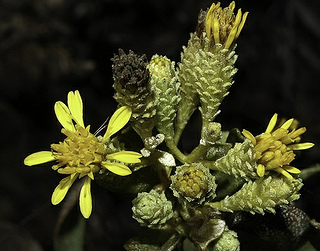(Hazardia orcuttii)
 Hazardia orcuttii. Photo © Keir Morse.
Hazardia orcuttii. Photo © Keir Morse.
Orcutt’s hazardia is a California threatened plant species, which means that killing or possessing plants collected from the wild is prohibited by the California Endangered Species Act (CESA). Orcutt’s hazardia is a perennial evergreen shrub that grows between twenty and eighty inches high with small yellow flowers that typically appear from August to October. The species occurs in clay soils in coastal sage scrub, mixed chaparral, or southern maritime chaparral ecosystems. Although it is not federally listed, Orcutt’s hazardia was included in the City of Carlsbad Habitat Management Plan, which was finalized in 2004 and requires conservation for known populations as well as any newly discovered populations. There is only one natural occurrence known to exist in California in an area managed by the Center for Natural Lands Management (CNLM), in San Diego County, near Encinitas. There are four other occurrences, also managed by the CNLM, that were established as part of a transplanting effort in 2003-2004. All of the occurrences have low recruitment, and the transplanted occurrences are declining according to the most recent data available from the California Natural Diversity Database. Orcutt’s hazardia also occurs in Baja California, Mexico, but the status of these populations is unknown, and the California populations are considered genetically distinct.
Threats to Orcutt’s hazardia include recreational use of habitat, invasive species, and fire. The species’ small population sizes also place it at risk of extinction from random events. While Orcutt’s hazardia occurs on land protected from development by a conservation easement held by CDFW and managed by the CNLM, indirect effects of development such as recreational use are still a threat. If additional habitat surrounding the conservation easement is developed, further habitat fragmentation will occur, threatening the ability of Orcutt’s hazardia to increase its population size via seed dispersal. Habitat fragmentation could also lead to further loss of pollinator habitat and subsequent loss of pollinators, which would likely result in a decrease in reproduction of Orcutt’s hazardia. Lack of knowledge about its reproductive ecology, habitat requirements, and fire ecology also threaten Orcutt’s hazardia.
There are several actions that can be taken to conserve Orcutt’s hazardia. These include additional surveys of potential habitat to identify any new populations, and cooperation with the CNLM to develop long-term monitoring and improve protection of the conservation easement through adaptive management. Public outreach should focus on educating recreational users about how to avoid harming Orcutt’s hazardia.
CDFW may issue permits for Orcutt’s hazardia pursuant to CESA, and you can learn more about the California laws protecting Orcutt’s hazardia and other California native plants. The remaining wild population of Orcutt’s hazardia occurs in CDFW’s South Coast Region. More information is also available from the U.S. Fish and Wildlife Service Species Profile for Orcutt’s Hazardia.
Updated 01/14/2014